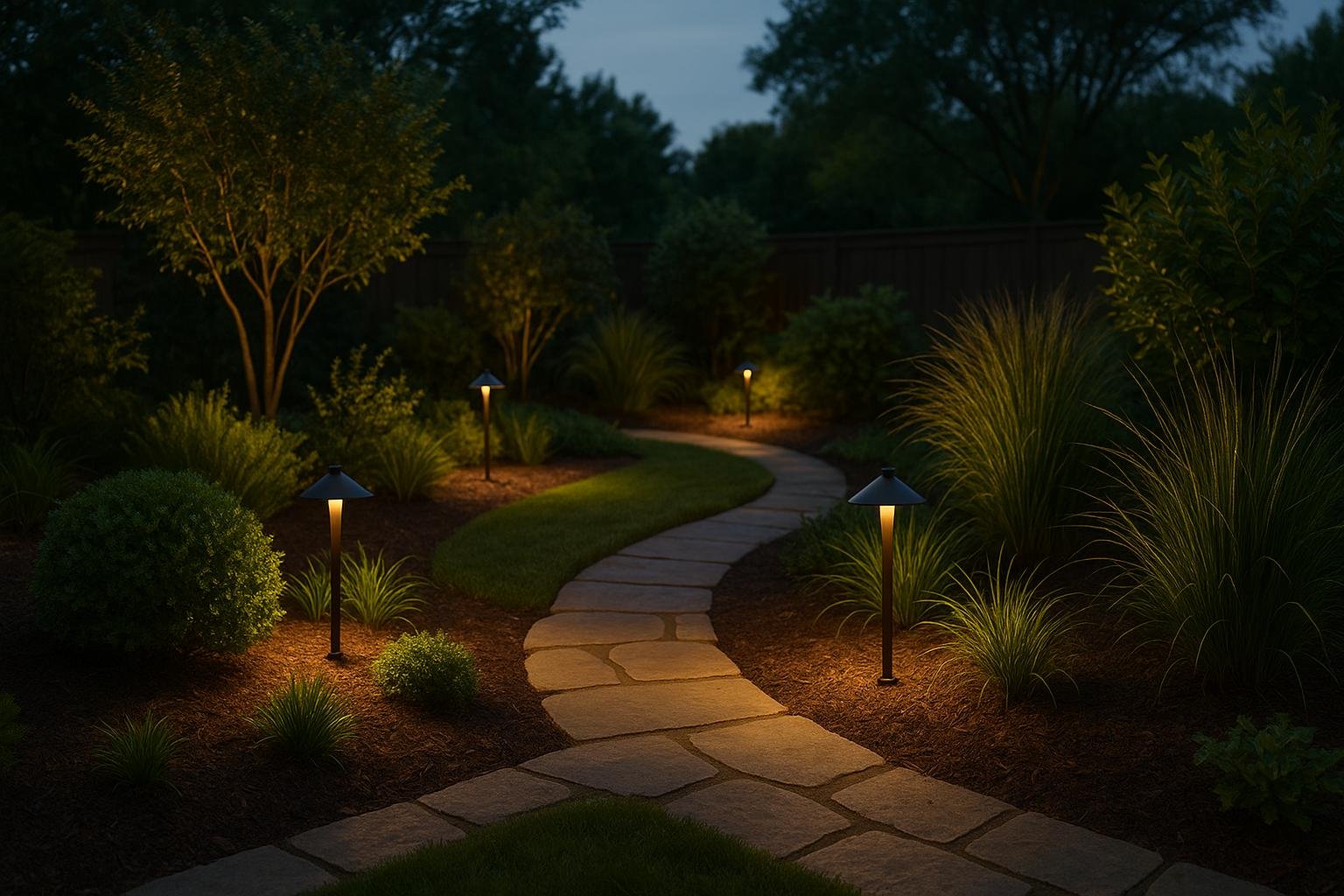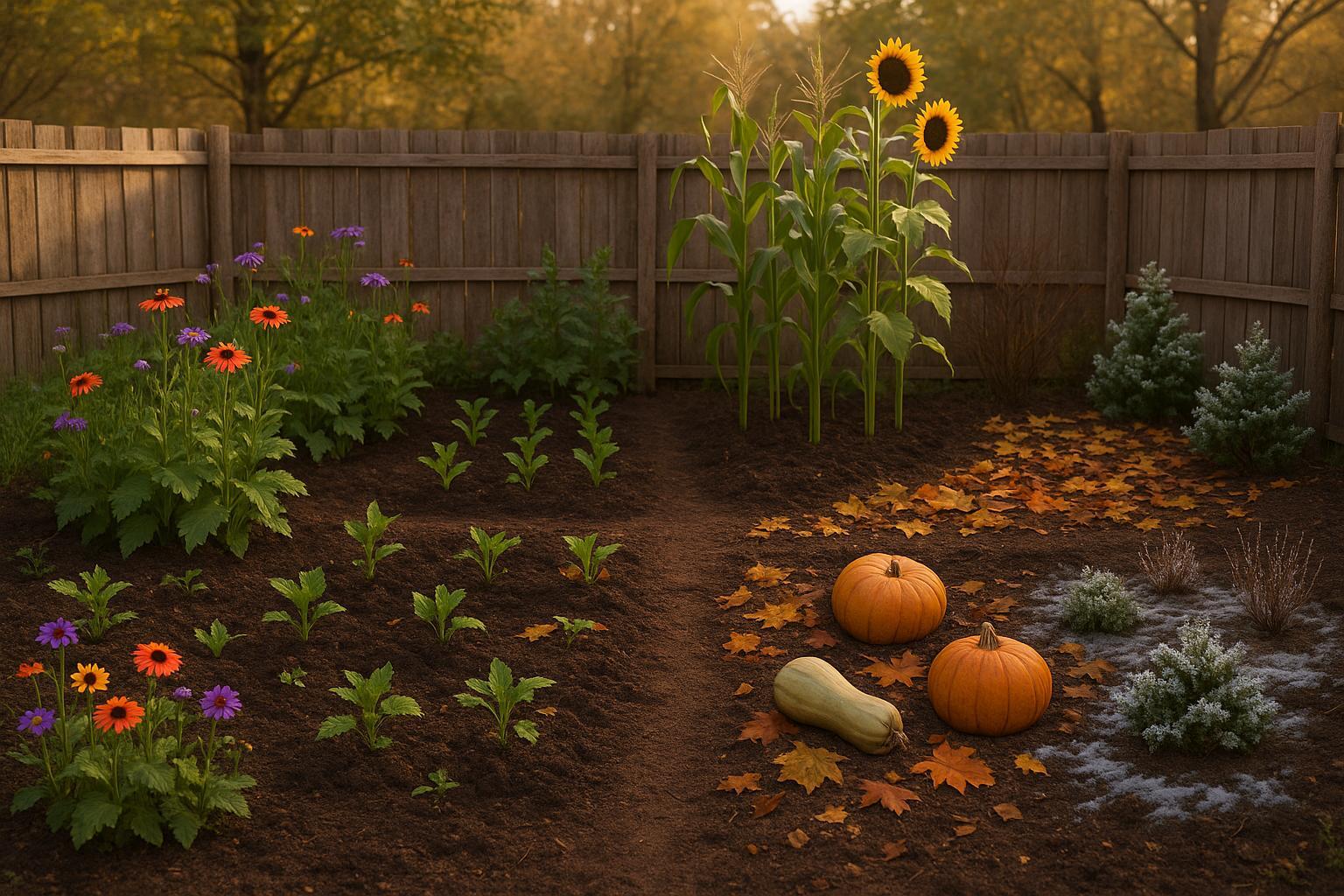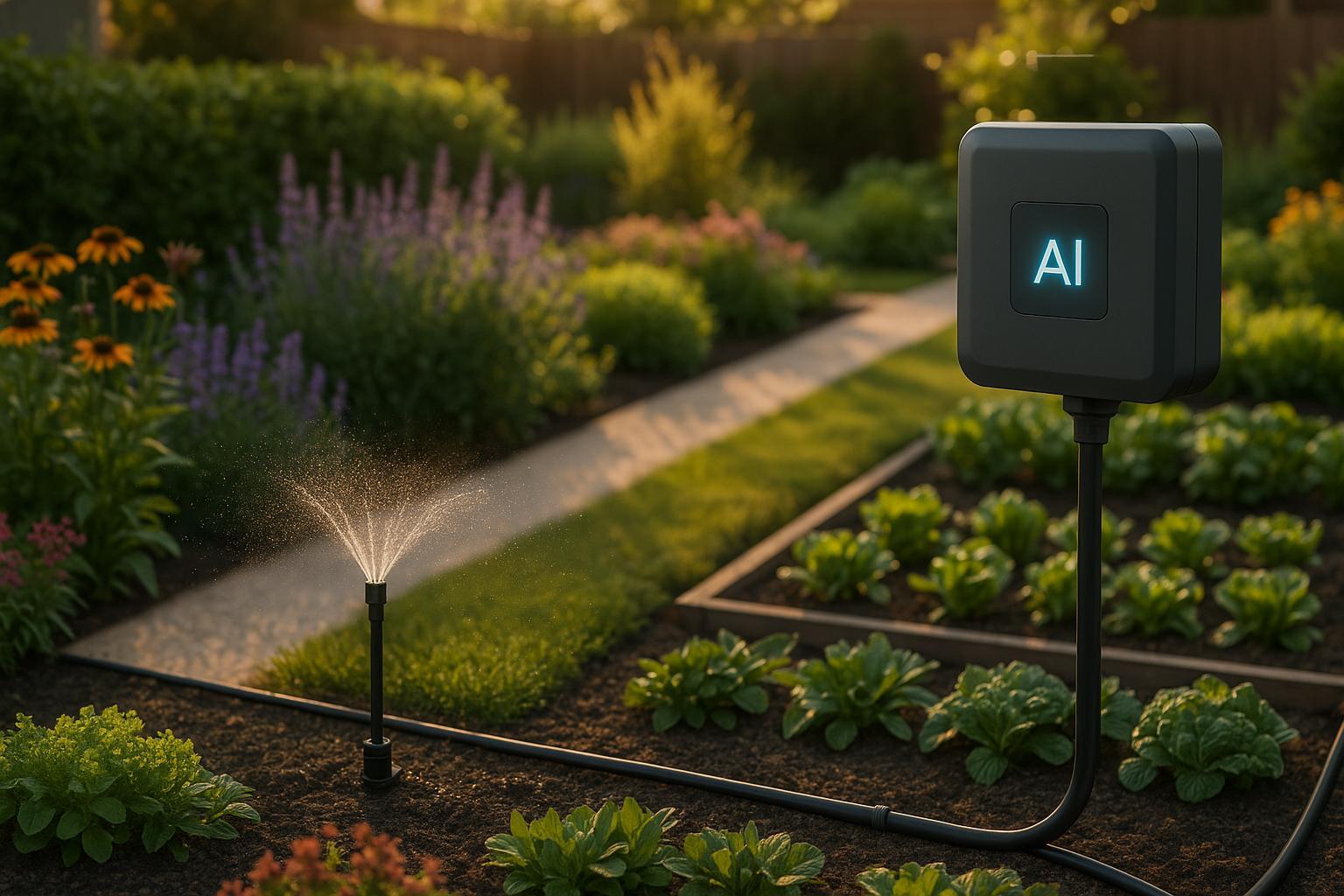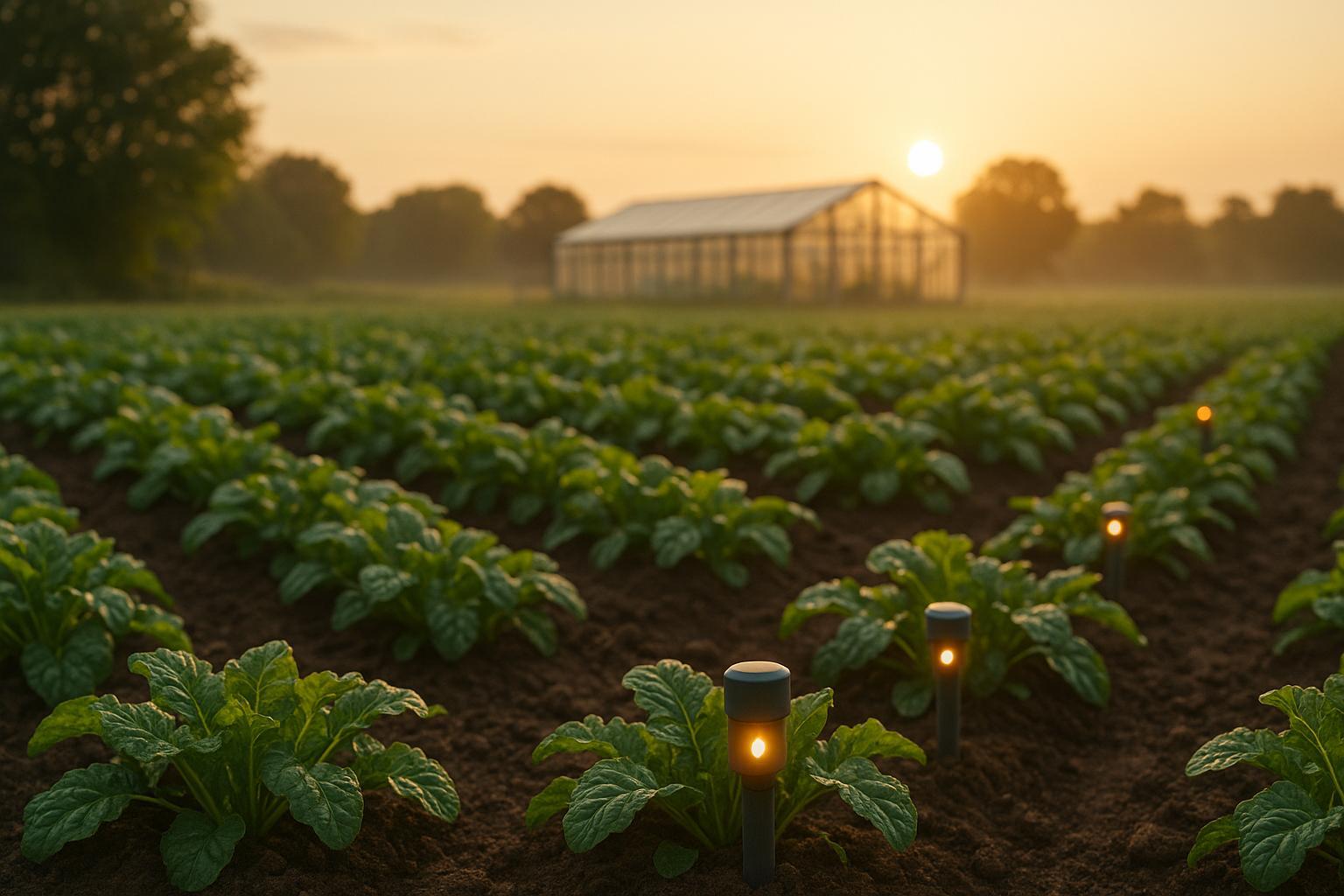How Low Voltage Lighting Saves Energy and Costs

Low voltage lighting is a practical way to cut energy use and reduce costs. These systems operate at 12 volts, using significantly less power than standard 120-volt systems. When combined with LED bulbs, they can save up to 85% on energy consumption. Key benefits include:
- Lower power bills: LEDs save households about $225 annually.
- Minimal maintenance: LED bulbs last up to 25 times longer than traditional options, reducing replacement costs.
- Safety: Operating at low voltage (12 or 24 volts) minimizes electrical shock risks.
- Outdoor efficiency: A 6-watt LED landscape light costs just $2 per year to run, compared to $24 for halogen bulbs.
These systems are ideal for pathways, gardens, and patios, offering efficient, long-lasting lighting with reduced environmental impact. Pairing low voltage systems with smart controls or AI planning tools can further optimize energy savings and design efficiency.
How Low Voltage Lighting Systems Work
What Is Low Voltage Lighting?
Low voltage lighting operates at 12 volts, which significantly lowers energy consumption and minimizes the risk of electrical shock. This makes it an excellent choice for outdoor spaces like gardens, walkways, and patios. Unlike the standard 120-volt household current, the reduced voltage is safer, especially in areas where children, pets, or moisture are present.
Let’s break down the key components that make these systems work so effectively.
Main System Components
Low voltage lighting systems consist of three primary parts: a transformer, wiring, and fixtures [6]. Together, these components ensure safe and efficient lighting.
The transformer is the system's powerhouse, converting standard 120-volt electricity to a safer 12-volt output [6]. When choosing a transformer, make sure the combined wattage of all connected fixtures stays below its maximum capacity. For flexibility, it’s a good idea to leave a 20–30% buffer for adding more fixtures in the future [7].
Wiring connects the transformer to the light fixtures [6]. These systems use specially designed cables that safely handle the 12-volt current. For setups requiring more power, thicker gauge wires help maintain proper current flow. Installation is straightforward - there’s no need for conduit, and polarity isn’t an issue [8].
Light fixtures are where the magic happens, providing the actual illumination. They come in a variety of styles tailored to different needs, such as path lights for walkways, spotlights for highlighting features, deck and step lights for safety, and even underwater lights for ponds or fountains. Fixtures typically connect to the main cable using wire connectors, making installation and maintenance hassle-free [8].
Best Uses for Outdoor Spaces
Low voltage lighting is perfect for outdoor areas where safety, efficiency, and aesthetics are priorities. While high voltage lighting works better for large spaces requiring intense brightness, low voltage systems shine in settings like pathways, patios, and gardens [6].
Pathways and walkways are some of the most common applications. Fixtures are usually spaced about 10 feet apart, creating pools of light that guide visitors safely along the route [6]. For added convenience, motion-sensor LEDs can provide light only when needed, boosting functionality [9].
Garden and landscape beds also benefit from low voltage lighting. These systems not only highlight planting beds but also act as markers for pathways. When lighting trees, aim to illuminate both the trunk and canopy to avoid a "floating" effect. Fixtures should be placed at least 20 feet apart to create distinct, visually appealing pools of light [10].
"You want pools of light to guide your eye from one plant to the next, not continuous illumination." – Mark Piantedosi, Owner of Commonwealth Landscape Lighting [10]
For patios, decks, and stairs, downlighting is a great option. It provides ample light without creating harsh glare. Step and deck lights can be seamlessly integrated into structures, ensuring safe movement after dark. Low voltage spotlights can also highlight architectural features like walls or chimneys, creating dramatic effects without the complications of high voltage systems [9].
The flexibility of low voltage lighting allows for creative combinations. Staggering pathway lights can create a relaxed, inviting atmosphere, while blending ambient, task, and accent lighting achieves a balanced look. Pairing these systems with LED technology can lower energy costs by up to 85% [6], making them both cost-efficient and environmentally friendly over time.
Energy Savings and Lower Costs
Reduced Power Usage
Low voltage systems operate on 12 volts instead of the standard 120 volts, significantly cutting energy consumption. When paired with LED technology, these systems can reduce energy use by up to 75% compared to traditional incandescent bulbs [3]. In fact, LEDs alone can lower power usage by as much as 85% when compared to conventional lighting options [6].
"One of the primary benefits of low-voltage lighting is its energy efficiency. These systems use significantly less electricity than traditional high-voltage lighting, helping you lower your energy bills." – Thomas Edison Electric [4]
This lower energy consumption directly translates into reduced monthly utility bills.
Monthly Bill Savings
Real-world examples from the U.S. highlight the cost-saving potential of low voltage LED lighting. For instance, halogen systems typically cost between $6 and $25 per month to operate, while equivalent LED setups can slash expenses by up to 76% [11]. In Connecticut, running 20 eight-watt LEDs for five hours daily costs less than $5 per month as of 2025. By comparison, similar halogen or incandescent systems cost $20–$25 monthly [12]. One homeowner shared how switching from a $25-per-month halogen system to an LED setup costing just $5 per month also reduced energy usage from 800 watts to 130 watts [13].
LED Fixtures Last Longer
The benefits of LED lighting go beyond energy savings - they also last much longer than traditional bulbs. This durability means fewer replacements and lower maintenance costs over time. Low-voltage LED systems, in particular, often last twice as long as their line voltage counterparts [14]. This longevity is largely due to the use of remote drivers, which are designed to be more efficient and generate less heat compared to the integrated drivers in standard voltage systems.
"When drivers are located separately from fixtures, they can be made to have higher efficiencies (because they can be bigger), and thus don't heat up as much. Heat is the main culprit in failed LED drivers, because the electrolytic capacitors (key component in the driver) have decreased lifespans at higher temperatures." – Cence Power [14]
Residential LEDs not only use at least 75% less energy than incandescent bulbs but can also last up to 25 times longer [2]. This extended lifespan means fewer replacements, which directly contributes to long-term savings.
Cost Comparison Chart
Here’s a quick look at how traditional halogen systems stack up against low voltage LED systems in terms of cost and lifespan:
| System Type | Monthly Cost | Annual Cost | Bulb Lifespan |
|---|---|---|---|
| Traditional Halogen (340W) | $13.78 | $165.36 | 1–2 years |
| Low Voltage LED (340W equivalent) | $3.27 | $39.24 | 15–25 years |
| Moderate Halogen System | $25.00 | $300.00 | 1–2 years |
| Equivalent LED System | $5.00 | $60.00 | 15–25 years |
These numbers show that low voltage LED systems typically cost 70–80% less to operate than traditional halogen setups. On average, households can save around $225 annually by making the switch to LED lighting [1], resulting in substantial long-term savings.
Safety and Environmental Benefits
Safer for Families
Low voltage systems operate at just 12 volts, significantly reducing the risk of electrical shocks for children and pets [16]. This lower voltage makes these systems a safer choice, especially in areas where safety is a priority [15][18].
The safety factor becomes even more critical during wet weather conditions. Unlike traditional 120-volt systems, which can become hazardous when exposed to moisture, low voltage systems remain safe even in rain or when sprinkler systems are in use [18]. Most commercial low voltage systems run on standard voltages such as 12V, 24V, or 48V, and the National Electrical Code (Article 411) classifies low voltage as between 0–30 volts [19][20].
To ensure maximum safety, always select fixtures labeled as "outdoor-rated" or "weatherproof" and use cables specifically designed to endure outdoor conditions [17]. Properly bury cables to avoid damage and tripping hazards, and use waterproof connectors for all electrical connections [17]. Additionally, installing GFCIs (Ground Fault Circuit Interrupters) provides an extra layer of protection [17].
Eco-Friendly Lighting Choice
Low voltage lighting goes beyond safety by offering meaningful environmental advantages. These systems use up to 80% less energy, which not only lowers electricity bills but also reduces carbon emissions and waste. With bulbs lasting up to 50,000 hours, the long lifespan further minimizes environmental impact [22]. For instance, replacing 10 high-voltage lights with low-voltage alternatives can cut carbon dioxide emissions by several hundred pounds annually [23].
LED bulbs used in low voltage systems are 100% recyclable and free of toxic materials, unlike compact fluorescent lamps that contain small amounts of mercury [21][22].
Another benefit is the reduction of light pollution. Low voltage systems allow for precise light placement, minimizing unnecessary light spillage that can disrupt nocturnal wildlife [22][23]. Many fixtures are also made from recyclable materials like aluminum or brass, further decreasing their environmental footprint [22][23].
Green Gardening Practices
Low voltage lighting pairs perfectly with eco-conscious gardening efforts. These systems produce less heat than traditional lighting, which helps protect nearby plants and can even reduce your home's cooling costs [22]. The reduced heat output means you can safely place fixtures closer to delicate plants without worrying about damage.
For a renewable lighting option, low voltage systems can be integrated with solar power [22][24]. When designing your garden lighting, choose fixtures made from sustainable materials like recycled brass or aluminum [23][24]. Opt for downward-facing, fully shielded fixtures to prevent light spillage and select amber or warm white light (around 2700K) to minimize blue light emissions that might interfere with plant growth cycles [23].
Using smart timers and motion sensors can help limit unnecessary lighting, conserving energy and extending the life of your system [23]. When it's time to replace fixtures, recycle old or damaged components through electronics recycling programs [23]. These practices not only enhance your garden's beauty but also contribute to its overall environmental health.
These thoughtful choices lay the groundwork for selecting and installing fixtures that maximize energy efficiency and sustainability.
🚀 Ready to Reinvent Your Garden?
Join thousands of homeowners who have transformed their gardens using our AI design tool. Upload one photo to explore endless possibilities.
Get your AI garden designs →Choosing and Installing the Right Fixtures
Picking Energy-Saving Fixtures
When selecting fixtures, aim for a balance of energy efficiency, durability, and functionality. LED fixtures are an excellent choice - they use at least 75% less energy and last up to 25 times longer than traditional incandescent bulbs [5]. Over time, this can lead to significant savings on energy bills.
Start by checking the IP rating of the fixture. For outdoor use, look for a rating of IP56 or higher to ensure protection against dust, dirt, and water [25]. When it comes to materials, brass and aluminum are strong options. They hold up well against the diverse weather conditions experienced across the U.S., whether it's the humid Southeast or the icy Northeast [25].
The beam angle of a fixture determines how the light spreads. Narrow beams are ideal for highlighting trees or architectural details, while wider beams provide better coverage for pathways or seating areas [25]. Brightness levels also matter - gardens typically need softer lighting, while pathways require more intense illumination for safety [25].
Consider the color temperature of the lights. Warm white (around 2700K) creates a welcoming ambiance and works well for most landscaping. Cooler tones, on the other hand, are often better for security lighting [26]. Fixtures with dimmable features offer flexibility, letting you adjust the brightness to suit different occasions and save energy [26].
Before purchasing, ensure all components - fixtures, cables, and transformer - are compatible. Most residential systems use 12 volts. Choose a transformer with a capacity 20–30% higher than your total wattage to avoid overload issues [26].
Once you've chosen your fixtures, you're ready to move on to installation.
Simple Installation Steps
Installing low-voltage lighting is both safe and straightforward compared to 120-volt systems. Start by planning your lighting layout. Walk around your property at night to identify areas that need lighting and mark potential fixture locations [8].
Place the transformer near a GFCI-protected outlet, ensuring it’s at least 12 inches off the ground and shielded from moisture [29]. Calculate your total wattage and confirm your transformer can handle the load with a 20–30% buffer.
Choose the right wire gauge for your setup. For distances up to 100 feet, 12-gauge wire is typically sufficient; for longer runs, use 10-gauge wire [8]. When laying cables, bury them at least 6 inches deep to protect them from lawn equipment. If possible, run wires along hardscapes like walkways or garden edges [27] [28].
Before digging, mark any existing cables or irrigation lines to avoid accidental damage [28]. Leave some slack in the wires near each fixture to allow for adjustments and reduce strain on connections [8]. Use waterproof wire nuts and wrap them with electrical tape to keep connections weatherproof [8].
Test the system immediately after installation. Confirm that all fixtures light up properly and adjust their angles as needed while the wiring is still accessible [27] [28]. To improve energy efficiency, add timers or photocells for automatic operation [7].
With your system in place, you can take it to the next level by incorporating smart controls.
Adding Smart Controls
Smart controls bring convenience and efficiency to your lighting system. They allow for remote control, automated scheduling, and customization, enhancing both functionality and curb appeal [29]. Since lighting accounts for about 15% of energy use in commercial buildings, similar savings can be achieved in homes [31].
A basic smart setup costs between $100 and $300, while more advanced systems with features like color-changing lights and app controls range from $200 to $500 [29]. For instance, the Stratus smart landscape lighting transformer starts at $299 and offers a wide range of control options [32]. Smart controls can be added to new systems or retrofitted into existing low-voltage setups [29].
Evaluate your current layout to identify where smart features would have the most impact [29]. Motion sensors are great for security and pathways, turning lights on only when movement is detected. Timers ensure lights operate during specific hours for added energy savings.
Smart lighting apps let you manage schedules, adjust brightness, and even experiment with colors, all from your phone [29]. You can create different lighting scenes for entertaining, security, or everyday use. Some systems integrate with home security cameras, offering features like occupancy simulation to help deter intruders [30] [31].
During installation, make sure all wiring is insulated and the transformer is protected from moisture [29]. Choose fixtures that can handle your local weather conditions, whether it’s intense sun or frequent rain [29].
"Integrating smart technology into low-voltage systems gives homeowners unparalleled flexibility to adapt their lighting to their lifestyle, all while maintaining energy efficiency." - John Carter, Landscape Lighting Expert [29]
Combining LED lighting with smart controls creates a system that’s efficient, adaptable, and tailored to your needs. It’s a solid foundation for a lighting setup that enhances both functionality and aesthetics.
sbb-itb-4d6a8dd
Planning Your Lighting with AI Garden Design Tools
Creating Lighting Plans with AI
Imagine uploading a photo of your garden and instantly receiving a professional lighting plan tailored to your space. That’s exactly what AIGardenPlanner’s AI Garden Design Generator offers. This tool analyzes the unique features of your garden to craft energy-efficient lighting layouts that enhance both functionality and aesthetics. With over 50 garden styles to choose from, you can experiment with different lighting designs without the expense and hassle of physical trial-and-error setups [34].
One of the standout features is its ability to calculate proper spacing for your lights, ensuring they not only look great but also save energy. By automating these critical decisions, the AI helps you design a low-voltage lighting system that delivers maximum impact while keeping energy waste to a minimum.
Instead of manually sketching layouts, you’ll receive visual previews showing how different lighting configurations will appear in your actual garden. This eliminates guesswork, prevents costly mistakes, and guarantees effective lighting performance. Plus, the tool goes a step further by offering location-specific guidance for optimal fixture placement based on your regional conditions.
Location-Based Recommendations
AIGardenPlanner doesn’t just stop at design - it provides location-specific advice tailored to your environment. Its AI Gardening Advisor uses your location data to generate customized recommendations, factoring in local climate conditions and landscaping trends [36][35]. Since climate heavily influences lighting choices, the tool evaluates your area’s weather patterns to suggest solutions that work best in your surroundings.
Beyond climate, it also considers local vegetation, seasonal changes, and regional landscaping styles to fine-tune fixture placement and selection. With input from over 10,000 gardeners worldwide, the platform’s recommendations are backed by real-world performance data [34]. This ensures your lighting system is not only visually appealing but also highly functional and suited to your garden’s unique environment.
Simplified Selection Process
Choosing the right lighting fixtures can be overwhelming, but AIGardenPlanner simplifies the process. Its AI Plant Advisor provides tailored recommendations based on your location, preferences, and climate zone [36]. It helps you select fixtures that align with your garden’s design and energy efficiency goals.
Whether you’re focusing on pathway safety lighting or accentuating landscaping features, the AI ensures all components work together seamlessly. For instance, it can demonstrate how to layer pathway lights with accent lights to create a polished, professional look [33].
The platform integrates technical details into its recommendations, ensuring compatibility and optimal performance. This cohesive approach not only enhances energy efficiency but also helps you save on costs in the long run.
With flexible pricing plans available, AIGardenPlanner caters to both single projects and ongoing landscaping needs [34][36]. Its average rating of 4.5/5 highlights how it streamlines complex design decisions. Users frequently praise the tool for helping them create well-coordinated, energy-efficient lighting systems that outperform traditional planning methods [34].
Why Low Voltage LED Landscape Lighting is Easier Than Halogen

Conclusion: Why Choose Low Voltage Lighting
Low voltage lighting can reduce energy consumption by up to 85% and last as long as 50,000 hours, helping you save on electricity and maintenance costs [37]. That means lower monthly bills and far fewer bulb replacements - a win for both your wallet and your time.
Operating at just 12 volts instead of the standard 120 volts, these systems are also much safer for families and pets [23]. On top of that, they use 60–70% less energy than traditional lighting systems, making them a more environmentally friendly option [23].
"Low-voltage landscape lighting is more than an aesthetic choice; it represents a commitment to a greener future." - OC Lights [23]
The appeal of low voltage lighting is on the rise, with outdoor usage increasing by 7% over the past five years [38]. And with tools like AIGardenPlanner, homeowners can make the most of their investment.
AIGardenPlanner takes the guesswork out of designing your outdoor lighting. By analyzing a photo of your garden, it creates an efficient layout tailored to your space, ensuring optimal fixture placement and spacing. This prevents energy waste and ensures your lighting system works efficiently throughout the year, no matter your climate.
Plus, the platform suggests compatible fixtures and calculates proper spacing, helping you avoid expensive DIY mistakes. Pairing the energy efficiency of low voltage lighting with AIGardenPlanner's precision design tools gives you the perfect combination: a beautifully lit outdoor space that’s cost-effective and expertly planned.
🎨 Visualize Your Dream Garden Today!
Transform any outdoor space into a professional landscape design in minutes. Just upload a photo, choose your style, and let our AI do the rest.
Start your garden transformation now →FAQs
How can I choose the right transformer size for my low voltage lighting system?
To determine the right transformer size for your low voltage lighting system, begin by calculating the total wattage of all the lights in your setup. Once you have this figure, pick a transformer with 20-30% more capacity than your total wattage. This additional capacity ensures the transformer can handle the load comfortably and leaves room for any future upgrades.
For instance, if your system's total wattage is 200 watts, go for a transformer rated at 250 watts or more. This not only supports efficient performance but also helps prolong the life of your lighting system.
What are the advantages of using smart controls with low voltage lighting systems?
Smart controls for low voltage lighting systems bring a host of advantages to the table. One standout feature is the ability to manage your lighting remotely. With just a smartphone or another device, you can adjust settings on the go. This not only adds convenience but also helps cut down on energy use by giving you precise control over when and where your lights are active.
Another benefit is the range of customization options these systems offer. Whether you want to dim the lights, set up schedules, or tweak colors to match a mood or event, smart controls let you tailor your lighting to fit your needs perfectly. On top of that, they can boost security by automating lights to mimic someone being home or by lighting up specific areas when motion is detected, offering added peace of mind.
By blending energy savings with modern features, smart controls turn low voltage lighting systems into a practical, efficient, and versatile solution for both your home and garden.
How does low voltage lighting help reduce light pollution and benefit the environment?
Low voltage lighting is an effective way to cut down on light pollution. By directing light precisely where it's needed, it avoids excessive brightness, glare, and that hazy glow that can obscure the night sky. This focused lighting not only improves the look of your outdoor spaces but also provides a more environmentally conscious solution.
Another key benefit is energy efficiency. Low voltage systems use less power, which means lower greenhouse gas emissions and a smaller carbon footprint. With low voltage lighting, you can create a beautifully lit outdoor area while playing your part in supporting a cleaner, healthier planet.
Related posts
Related Articles

10 Indigenous Gardening Practices by Season
Explore Indigenous gardening practices that enhance plant health, conserve resources, and align with seasonal cycles for sustainable gardening.

DIY Garden Statues: A Creative Guide to Enhance Your Outdoor Space
Learn how to make garden statues to add a personal touch to your outdoor space. Explore materials, techniques, and tips for a successful project.

How AI Improves Garden Water Allocation
Explore how AI-driven irrigation systems optimize water usage, enhance plant health, and reduce costs in garden management.

How AI Tracks Irrigation Performance in Real Time
Explore how AI-driven irrigation systems optimize water usage and enhance crop yields through real-time monitoring and predictive analytics.

What Is Green-on-Green Spray Technology?
Explore how green-on-green spray technology revolutionizes weed control by using AI for precise herbicide application, reducing chemical use significantly.

How Sensor Networks Detect Plant Diseases Early
Learn how sensor networks enable early detection of plant diseases, improving crop health and reducing losses through real-time monitoring and AI analysis.